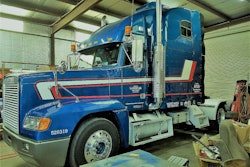 The mammoth state of Texas’ parking study is the result in no small part of long engagement with the driver community and its parking advocates. The study ultimately urges action from the state DOT on numerous fronts, including advocating itself for parking needs in a variety of venues.
The mammoth state of Texas’ parking study is the result in no small part of long engagement with the driver community and its parking advocates. The study ultimately urges action from the state DOT on numerous fronts, including advocating itself for parking needs in a variety of venues.Flying under the radar of the COVID-19 pandemic news these past weeks, the Texas Department of Transportation quietly debuted its findings into multi-year research around truck parking issues in the state — and steps that can be taken to bolster available parking.
Among its dizzying assemblage of facts and figures, the Statewide Truck Parking Study earmarked 1,887 miles of highway freight corridors where parking needs are currently of the utmost urgency, designating them highest priority. Further, it projects out to year 2050, when high priority areas could include 30% of all miles of I-10 in the state, a quarter of I-20 and almost half of I-35’s north-south miles, among other corridors.
In the study’s executive summary, for those who are fully prepared (I know, I know) to roll those eyes at mention of another parking study, there’s this, too, about those highest-priority areas: “The State should undertake near-term expansion and upgrading of truck parking facilities in the highest need areas.”
That’s adding capacity, of course, what so many truckers have sought over the last decade and more of parking advocacy efforts.
Adding capacity takes dollars — quite a lot of them in many cases. And though I’m no student of Texas taxpayer revenues and state budgeting, I don’t imagine such a high-priority recommendation for added truck-parking capacity could come at a worse time for those who would follow through on the call to action.

At once, the nearly 140-page statewide study is rich with detail, including near its end a collection of exhibits that include site-specific recommendations for expansion of existing facilities and new facilities, with some that could be placed near higher-density areas where needs are greatest. And among its recommendations, perhaps most importantly, it urges TxDOT to take an active role in spurring truck-parking investment and development outside the areas that are directly within the agency’s control, i.e. to take the role of advocate in the truck-parking fight, to an extent.
For instance, from Page 118:
TxDOT Support Action 1: The State Should Advocate for Truck Parking at Non-TxDOT Public Facilities (Commuter Lots, Bus Depots, Maintenance Lots) During Off-Hours — TxDOT should work with partner agencies and municipalities to identify commuter parking lots, bus depots, or other facilities that could support truck parking during off-hours in high demand areas.
This is but one example, and is a direct one of how so many truck drivers’ engagement on this issue has spurred more creative thinking among researchers studying (and planners planning for) it in Texas, for sure. Keeping the issue front and center for your local Metropolitan Planning Organizations and state agencies, wherever you are, will probably be tougher in this time than it was several months ago, but it’s not impossible.
For now, take the time to peruse the Texas Statewide Truck Parking Study via this link, where you can access it in full. For the brief Executive Summary version, follow this link.
ATHS National Convention goes virtual, including truck show: Deadline for entries May 15
My colleagues at Truckers News had this story yesterday, making note of the fast-approaching deadline for participation in the American Truck Historical Society’s big annual meet, which had been scheduled for May 28-30 in Springfield, Ill. The live event, as so many have been, was canceled as COVID-19 took hold, but ATHS organizers have taken the program virtual. That includes the truck show, which they’re actively opening up to global participation — for my money, that ought to make for some one-of-a-kind entries this year.
You can participate yourself via this link to the truck-show-entry page. The online convention’s schedule of events you can find via this link.










